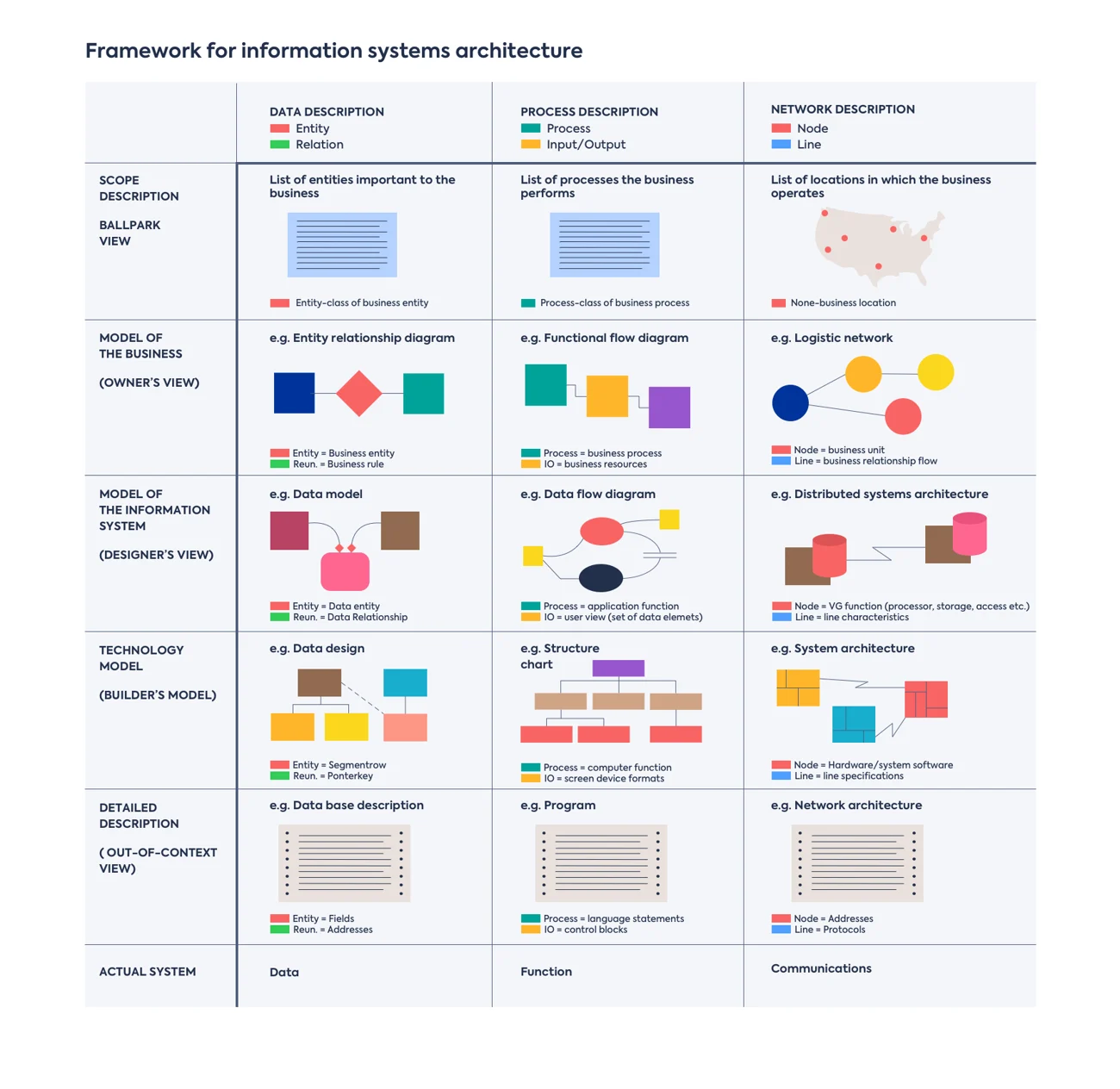Zachman - A DEFINITIVE GUIDE
The Zachman Framework Guide
Introduction
Enterprise Architecture (EA) is a strategic practice that aligns an organization’s structure and operations to optimize processes through unified IT and business goals. It involves:
- Defining organizational structure
- Organizing workflows
- Standardizing procedures
- Documenting processes
EA is essential for promoting efficient resource sharing across departments. It has evolved to include various frameworks, such as:
- Zachman Framework
- TOGAF
- FEAF
- Gartner’s Enterprise Architecture Framework
These frameworks guide architects in creating a structured approach to EA.
Zachman Framework Explained
The Zachman Framework is a structured schema used for categorizing and organizing the complex details of enterprise architecture. It focuses on:
- Artifacts: Design documents, specifications, models
- Perspectives: Business owners, system builders
- Issues: Data, functionality
Created by John Zachman in the 1980s, it was later refined to include six descriptive focuses:
- Data
- Function
- Network
- People
- Time
- Motivation
…and perspectives corresponding to different roles:
- Planner
- Owner
- Designer
- Builder
- Subcontractor
- Enterprise
This framework is not a one-size-fits-all solution; it’s updated to suit modern complexities in IT and business processes.
Ontology vs. Methodology
It’s crucial to understand that the Zachman Framework is an ontology (a structural model), not a methodology (a process model). Here’s the difference:
- Ontology: Defines concepts and relationships within a domain.
- Methodology: Provides steps for transformation from one state to another.
Ontologies are about classification and definition, while methodologies focus on predictable transformation processes.
Primitives vs. Composites
In the context of EA:
- Primitives: Fundamental elements that define the existence of an object.
- Composites: Implementations that combine these primitives in temporal ways.
For instance, the periodic table (ontology) vs. chemical reactions (methodology).
Why Use the Zachman Framework?
The Zachman framework offers:
- A multidimensional perspective on enterprise questions: What, How, When, Who, Where, and Why.
- A holistic view of enterprise architecture for planning and evaluation.
- A proactive tool for modeling organizational functions and structures.
It differs from life cycle-based frameworks like TOGAF by focusing on stakeholders’ viewpoints.
Zachman Framework’s Structure

The framework features:
- 36 categories: Covering nearly all aspects of an enterprise.
- Two-dimensional matrix: With six rows (perspectives) and six columns (interrogatives).
Each cell in the matrix provides a specific viewpoint for a particular stakeholder.
Columns (Interrogatives)
These columns address key enterprise questions:
- What: Objects and data.
- How: Business processes.
- Where: Locations of operations.
- When: Timing and frequency of processes.
- Why: Justifications and motivations for choices.
Rows (Perspectives)
These rows represent stakeholder viewpoints:
- Planner: Business strategies and purposes.
- Owner: High-level organizational directives.
- Designer: IT system designs.
- Implementer: Technology constraints during implementation.
- Sub-Constructor: Detailed system component specifications.
- User: Operational system functionality.
Rules of the Zachman Framework
John Zachman proposed seven rules:
- Maintain the original number of rows and columns.
- Each column should have a unique, simple model.
- Customize models for each cell based on perspective constraints.
- Avoid overlapping models across columns.
- Do not create diagonal relationships between cells.
- Keep consistent naming for rows and columns.
- Apply the framework’s recursive logic universally.
Zachman vs. TOGAF

Zachman is agile and flexible, focusing on ontology, while TOGAF offers a step-by-step methodology. Both can complement each other, with Zachman categorizing artifacts and TOGAF detailing the EA creation process.
Zachman Certifications
For EA professionals, the Zachman Certified - Enterprise Architect Program enhances skills and career prospects. It includes four levels:
- Enterprise Architect Associate
- Enterprise Architect Practitioner
- Enterprise Architect Professional
- Enterprise Architect Educator
This certification is recognized for its relevance and can boost career opportunities, often in conjunction with TOGAF.
Conclusion
Although not as widely used as before, the Zachman framework remains a vital component of EA strategies, serving as a blueprint for complex systems. When integrated with methodologies like TOGAF, it can enhance the agility and adaptability of enterprise architecture planning.